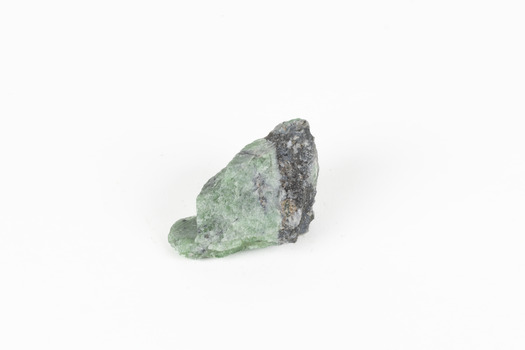Historical information
Feldspar, derived from the German word feldspat, is a group of minerals which is the most common mineral group found on Earth, making up more than half of the planet's crust. The major rock-forming minerals in the Feldspar group include albite, anorthite, orthoclase and microcline. (Mindat, Feldspar Group). Orthoclase is part of the Feldspar Group subgroup, Alkaline Feldspar, which are known to be poor in calcium, and mostly rich in potassium. It is further also considered to be a K Feldspar, a subgroup of Alkaline Feldspar that are Potassium-dominant with variable crystal symmetry and Al-Si ordering state.
Orthoclase are most commonly Colorless to white, Greenish white, Grayish yellow, or Pale pink and transparent to translucent with slightly pearly cleavage. The mineral rates at a 6 on the Mohs Hardness Scale. (cannot be scratched with a knife, but scratches glass with difficulty). The stronger green colour of this particular specimen is distinctive to the Broken Hill region (where it was found), and due to a small amount of lead. (BB) Its qualities find it misidentified at times as as microcline variety amazonite.
Broken Hill is one of the world’s richest lead-zinc-silver deposits. The huge, 300-million-tonne orebody was discovered in 1883 and the superb mineral specimens attract collectors from around the world. (Australian Museum, Minerals from Australia: Australian mining regions)
Significance
While feldspar is not by any means rare, this particular specimen has qualities distinctive to the Broken Hill mining district, with these properties leading at times to the mineral's misidentification. This creates potential for further study and identification of these mineral deposits through methods such as microscopic twinning, or using the position of certain d values in XRD patterns to calculate the degree of disorder of a K-feldspar, as discussed on the Mindat website (Mindat.com, Orthoclase:About Orthoclase).
This specimen is part of a larger collection of geological and mineral specimens collected from around Australia (and some parts of the world) and donated to the Burke Museum between 1868-1880. A large percentage of these specimens were collected in Victoria as part of the Geological Survey of Victoria that begun in 1852 (in response to the Gold Rush) to study and map the geology of Victoria. Collecting geological specimens was an important part of mapping and understanding the scientific makeup of the earth. Many of these specimens were sent to research and collecting organisations across Australia, including the Burke Museum, to educate and encourage further study.
Physical description
A solid small aluminosilicate mineral composition which is primarily pale green and blue-grey in colour with traces of beige and white throughout. Note: green plumbian orthoclase (aka green feldspar) is an indicator mineral for the Broken Hill style lead-zinc deposits.
Inscriptions & markings
N/A
Subjects
References
- Orthoclase Mineral Data Webmineral information page on Orthoclase mineral
- Albert Chapman Collection Australian Museum has a similar specimen from their Albert Chapman Collection - object number D.49930, Orthoclase feldspar (lead bearing) South Mine, Broken Hill, New South Wales, Australia.
- Alkali Feldspar Information on sub-group Alkali Feldspar
- K Feldspar Information on sub-group K Feldspar
- Orthoclase Information on Orthoclase mineral specimens
- Feldspar group Information on Feldspar mineral group.
- Feldspar Britannica definition of the mineral composition feldspar
- Plumbian Orthoclase Discussion surrounding the misidentification of plumbian orthoclase common to the Broken Mine district.
- Mineral properties List of mineral properties by Australian Museum
- Mohs hardness Further explanation of Mohs Hardness scale
- Minerals from Australia: Australian mining regions Accessed 25/09/2023
- Geological Collections Preservation and collection management advice for museums regarding geological specimens, developed by WA Museum.








